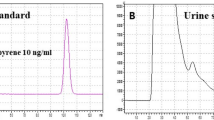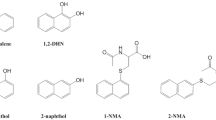Abstract
Objective: To investigate whether methyltetrahydrophthalic acid (MTHP acid) in urine can be used as a biomarker for exposure to methyltetrahydrophthalic anhydride (MTHPA). Methods: Workers occupationally exposed to MTHPA were studied in combination with one of the authors, who was experimentally exposed to MTHPA. Air levels of MTHPA were determined by personal sampling in the breathing zone. The MTHPA in air was sampled by silica gel and analyzed by gas chromatography (GC) with electron-capture detection. Urinary levels of MTHP acid, a metabolite of MTHPA, were determined in 15 subjects in total. Urine was collected from 14 workers immediately before the start of the work shift and then after 4 and 8 h, and from one of the authors at intervals during 24 h. MTHP acid in urine was analyzed by GC with mass spectrometric detection. Results: The time-weighted average (TWA) air levels ranged from 1.0 μg to 200 μg MTHPA/m3 during 8 h work shifts. The urinary levels of MTHP acid increased during exposure and decayed after the end of exposure, with an estimated half-time of about 3 h. A close correlation was found between the TWA air levels of MTHPA and creatinine-adjusted MTHP acid levels in urine collected at the end of the shift (r=0.955; P<0.0001). The current occupational exposure limit of 50 μg MTHPA/m3 (Japan Society for Occupational Health) corresponded to about 1300 μg MTHP acid/g creatinine, which was equivalent to about 900 nmol/mmol creatinine in the International System of Units (SI). Conclusions: These results indicate that the determination of MTHP acid in urine is suitable for use in the biological monitoring of MTHPA exposure.



Similar content being viewed by others
References
Japan Society for Occupational Health (2003) Recommendation of occupational exposure limits (2003–2004). J Occup Health 45:254–269
Johannesson G, Rosqvist S, Lindh C, Welinder H, Jönsson B (2001) Serum albumins are the major site for in vivo formation of hapten-carrier protein adducts in plasma from humans and guinea-pigs exposed to type-1 allergy inducing hexahydrophthalic anhydride. Clin Exp Allergy 31:1021–1130
Johannesson G, Lindh C, Nielsen J, Bjork B, Rosqvist S, Jönsson B (2004) In vivo conjugation of nasal lavage proteins by hexahydrophthalic anhydride. Toxicol Appl Pharmacol 194:69–78
Johyama Y, Yokota K, Takeshita T, Morimoto K (1999) Determination of methyltetrahydrophthalic anhydride in air using gas chromatography with electon-capture detection. Ind Health 37:364–368
Jönsson B, Skerfving S (1993) Toxicokinetics and biological monitoring in experimental exposure of humans to gaseous hexahydrophthalic anhydride. Scand J Work Environ Health 19:183–190
Jönsson B, Welinder H, Skarping G (1991) Hexahydrophthalic acid in urine as an index of exposure to hexahydrophthalic anhydride. Int Arch Occup Environ Health 63:77–79
Jönsson B, Welinder H, Hansson C, Ståhlbom B (1993) Occupational exposure to hexahydrophthalic anhydride: air analysis, percutaneous absorption, and biological monitoring. Int Arch Occup Environ Health 65:43–47
Lindh C, Jönsson B (1994) Method for analysis of methyltetrahydrophthalic acid in urine using gas chromatography and selected ion monitoring. J Chromatogr 660:57–66
Lindh C, Jönsson B, Welinder H (1997) Biological monitoring of methylhexahydrophthalic anhydride by determination of methylhexahydrophthalic acid in urine and plasma from exposed workers. Int Arch Occup Environ Health 70:128–132
Nielsen J, Welinder H, Skerfving S (1989) Allergic airway disease caused by methyl tetrahydrophthalic anhydride in epoxy resin. Scand J Work Environ Health 15:154–155
Nielsen J, Welinder H, Horstmann V, Skerfving S (1992) Allergy to methyltetrahydrophthalic anhydride in epoxy resin workers. Br J Ind Med 49:769–775
Palacian E, Gonzalez P, Pineiro M, Hernandez F (1990) Dicarboxylic acid anhydrides as dissociating agents of protein-containing structures. Mol Cell Biochem 97:101–111
Pfäffli P, Savolainen H, Keskinen H (1989) Determination of carboxylic acids in biological samples as their trichloroethyl esters by gas chromatography. Chromatographia 27:483–488
Tarvainen K, Jolanki R, Estlander T, Tupasela O, Pfäffli P, Kanerva L (1995) Immunologic contact urticaria due to airborne methylhexahydrophthalic and methyltetrahydrophthalic anhydrides. Contact Dermatitis 32:204–209
Welinder H, Gustavsson C (1992) Methyltetrahydrophthalic anhydride in air-sampling and analysis. Ann Occup Hyg 36:189–197
Welinder H, Nielsen J, Gustavsson C, Bensryd I, Skerfving S (1990) Specific antibodies to methyltetrahydrophthalic anhydride in exposed workers. Clin Exp Allergy 20:639–645
Yokota K, Johyama Y, Yamaguchi K, Takeshita T, Morimoto K (1999) Exposure-response relationships in rhinitis and conjunctivitis caused by methyltetrahydrophthalic anhydride. Int Arch Occup Environ Health 72:14–18
Author information
Authors and Affiliations
Corresponding author
Rights and permissions
About this article
Cite this article
Yokota, K., Johyama, Y., Kunitani, Y. et al. Methyltetrahydrophthalic acid in urine as an indicator of occupational exposure to methyltetrahydrophthalic anhydride. Int Arch Occup Environ Health 78, 413–417 (2005). https://doi.org/10.1007/s00420-005-0608-8
Received:
Accepted:
Published:
Issue Date:
DOI: https://doi.org/10.1007/s00420-005-0608-8




